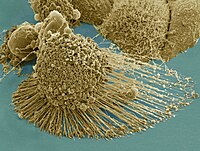
Photo from wikipedia
Urea derivatives are extensively used in the pharmaceutical industry. However, the unsatisfactory level of their membrane penetration requires further modification of the structures with stronger lipophillic properties. Phenylurea has a… Click to show full abstract
Urea derivatives are extensively used in the pharmaceutical industry. However, the unsatisfactory level of their membrane penetration requires further modification of the structures with stronger lipophillic properties. Phenylurea has a phenyl group that enables easier membrane penetration as a result of stronger pharmacological activity. Activity prediction was conducted by docking experiments and molecular dynamics, performed with Molegro Virtual Docker 5.5 using checkpoint kinase 1 (CHK1) enzyme with ID PDB: 2YWP. ADMET prediction was applied to collect data using the pkCSM tool. N -(phenyl carbamyol)benzamide compounds, modified by the Schotten Baumann method, were synthesized from benzoil chloride reacting with N -phenylurea. For evaluating anticancer activity, the MTT assay method on HeLa cells was used. Derived from the docking experiments, the compound rerank score of the N -(phenylcarbamoyl)benzamide was 72.0603 kcal/mol, lower than that of hydroxyurea, -32.1514 kcal/mol, causing better inhibitory activities against HeLA cell lines due to higher cytotoxic effects. ADMET Predictor was employed, indicating satisfactory compound distribution with a low, favorable metabolism, possessing good excretion and non-toxicity. The synthesized compound was 82% N- (phenyl carbamoyl)benzamide with 0.8 mM IC 80 , higher than that of hydroxyurea, 4.3 mM. In conclusion, successfully synthesized N- (phenylcarbamoyl)benzamide was proved to have higher cytotoxic effects. The satisfactory values of these compounds indicate that they are promising anticancer drug candidates.
Journal Title: Journal of Mathematical and Fundamental Sciences
Year Published: 2020
Link to full text (if available)
Share on Social Media: Sign Up to like & get
recommendations!